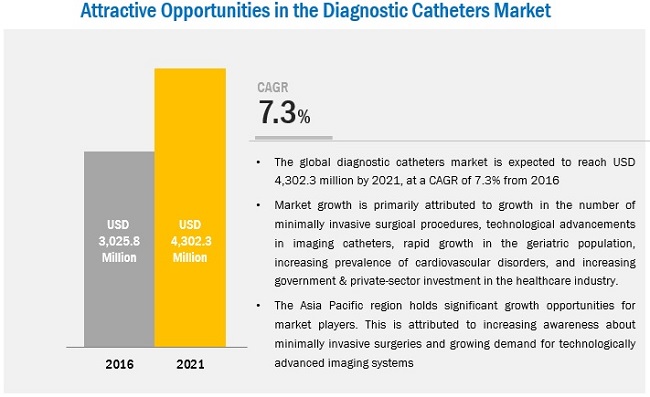
Diagnostic catheters are useful in performing various diagnostic procedures using different imaging techniques. The diagnostic catheters market is expanding with the emergence of new applications and technologies. These catheters are being used for several indications in different application areas such as cardiology, urology, gastroenterology, neurology, and others. Continuous ongoing improvements in catheter designs to simplify their use and make them safer and more effective are playing a pivotal role in growth of the market.
Drivers
- Growth in number of minimally invasive surgical procedures
- Technological advancements in imaging catheters
- Rapid growth in geriatric population and growing prevalence of CVD’s
Restraints
- Reuse of disposable diagnostic catheters
- Dearth of skilled professionals
Opportunities
- Untapped emerging markets
The overall diagnostic catheters market is projected to reach USD 4,302.3 million by 2021 from USD 3,025.8 million in 2016, at a CAGR of 7.3%.
OCT has revolutionized the medical imaging industry and has extended its applications in disease diagnosis and imaging of various cellular and molecular processes in vivo. The successful application of OCT imaging in various diagnostic areas such as cardiology has resulted in greater adoption of OCT imaging catheters by doctors for various diagnostic indications. The resolution limits of coronary angiography, along with the need for greater precision during percutaneous interventions have resulted in increased demand for high-resolution intracoronary imaging techniques such as OCT. These varied advantages of OCT imaging have drawn a number of market players to launch new OCT imaging systems and catheters for diagnostic applications. In October 2013, St. Jude Medical launched an OCT-assisted system for coronary imaging in the US.
The diagnostic catheter market in APAC is expected to grow at the highest CAGR during the forecast period. The growing patient population, increasing awareness about healthcare, growing per capita healthcare expenditure, government initiatives, and growing investments to modernize the healthcare infrastructure in these regions is expected to drive market growth in developing economies. Moreover, regulatory policies in the Asia-Pacific region, being more adaptive and business-friendly than those in developed markets, have led to a surge in the region’s healthcare industry, which is positively affecting the market.
Download FREE Brochure:
https://www.marketsandmarkets.com/pdfdownloadNew.asp?id=114053400